Bushfire Prevention: A Review of Australian Land & Building Management
VerifiedAdded on 2023/04/07
|10
|1980
|160
Literature Review
AI Summary
This literature review examines bushfire prevention techniques in Australia, emphasizing land management, building management, and community education. It evaluates the effectiveness of methods like fuel reduction, firebreaks, building regulations, and public awareness campaigns. The review highlights the importance of early detection systems, remote sensing, and fire risk rating frameworks. It also stresses the role of individual responsibility and community-based approaches in minimizing bushfire risks. The conclusion supports the research findings, recommending the removal of flammable materials, proper vegetation management near electrical cables, and the use of non-flammable building materials to mitigate fire hazards.
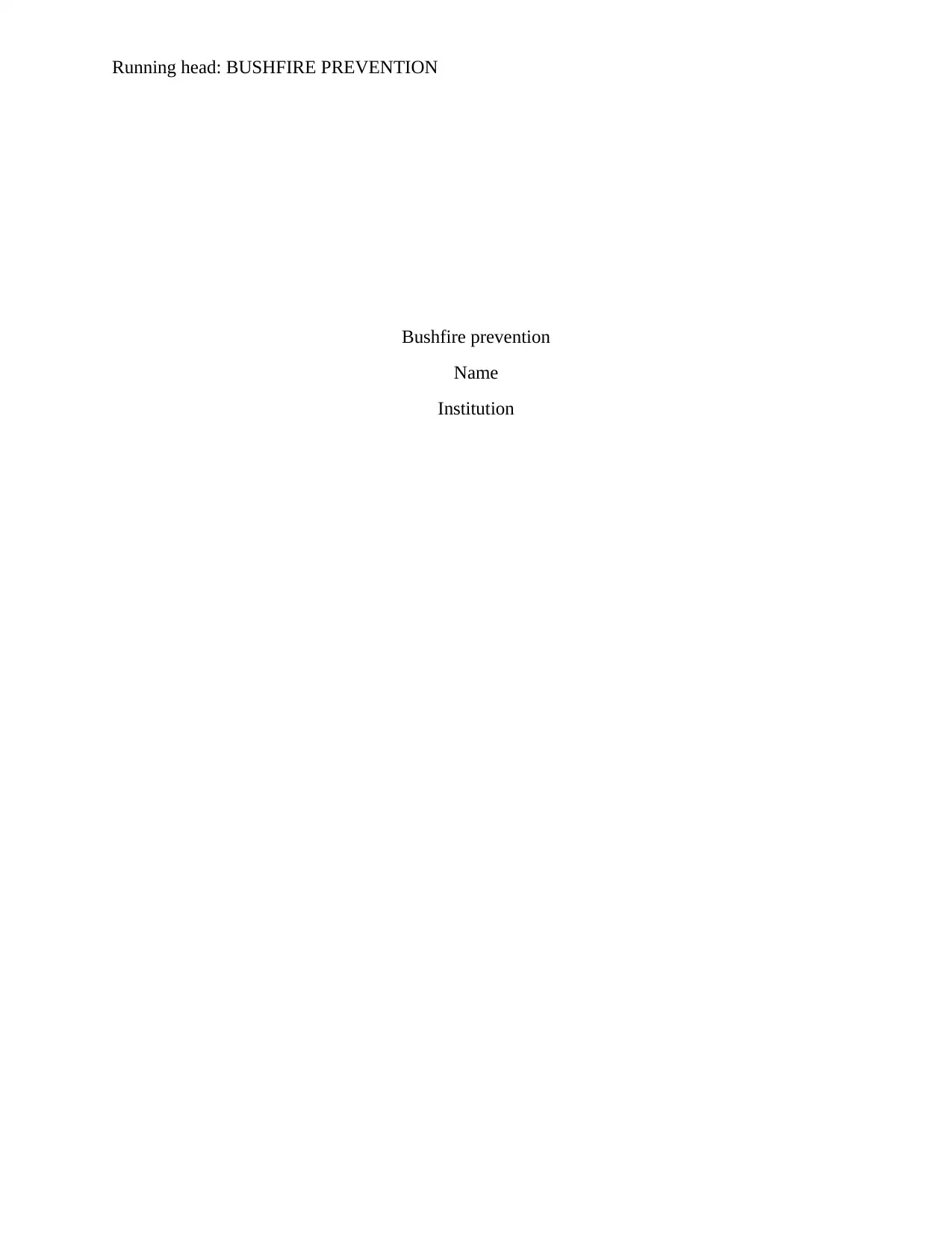
Running head: BUSHFIRE PREVENTION
Bushfire prevention
Name
Institution
Bushfire prevention
Name
Institution
Paraphrase This Document
Need a fresh take? Get an instant paraphrase of this document with our AI Paraphraser
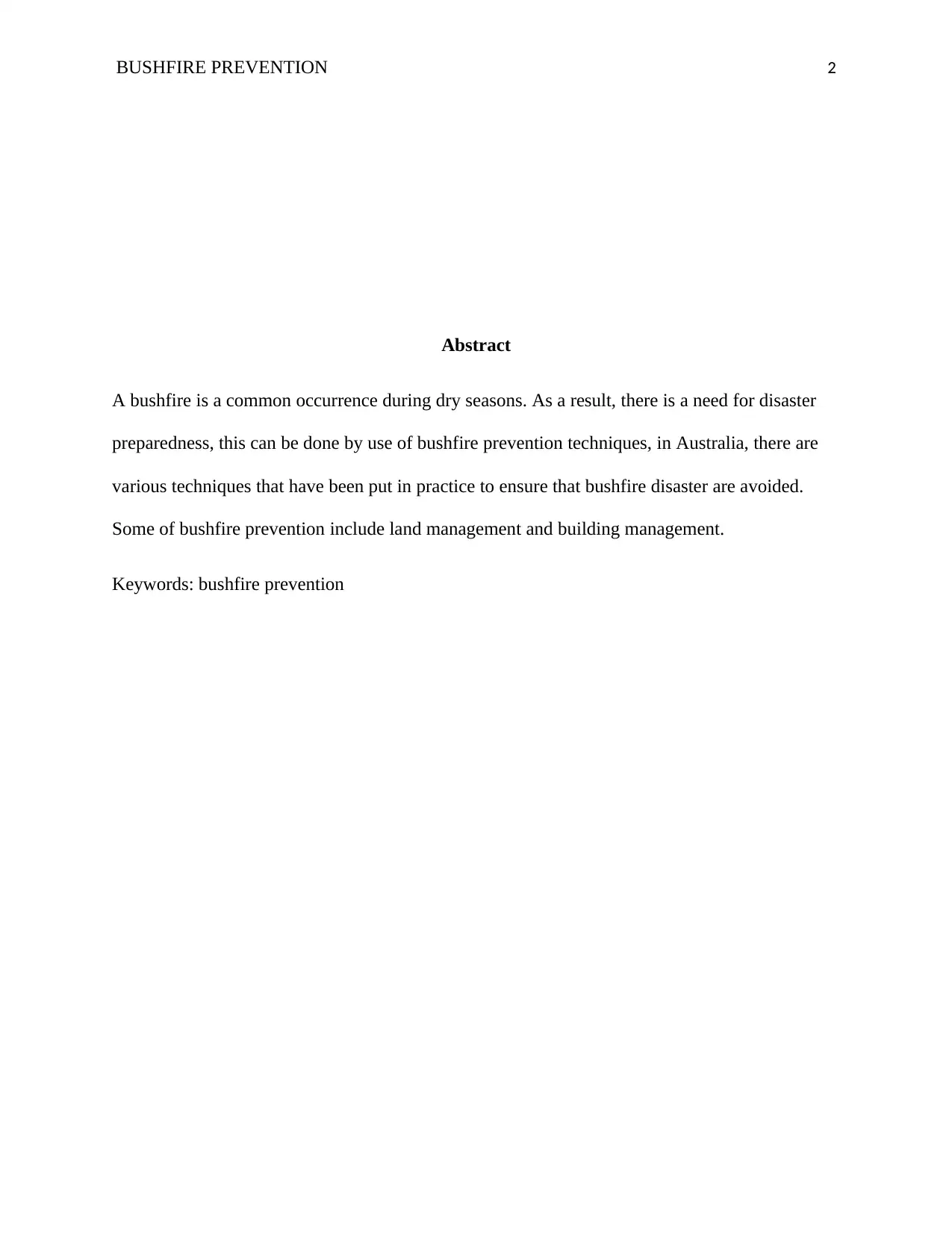
BUSHFIRE PREVENTION 2
Abstract
A bushfire is a common occurrence during dry seasons. As a result, there is a need for disaster
preparedness, this can be done by use of bushfire prevention techniques, in Australia, there are
various techniques that have been put in practice to ensure that bushfire disaster are avoided.
Some of bushfire prevention include land management and building management.
Keywords: bushfire prevention
Abstract
A bushfire is a common occurrence during dry seasons. As a result, there is a need for disaster
preparedness, this can be done by use of bushfire prevention techniques, in Australia, there are
various techniques that have been put in practice to ensure that bushfire disaster are avoided.
Some of bushfire prevention include land management and building management.
Keywords: bushfire prevention
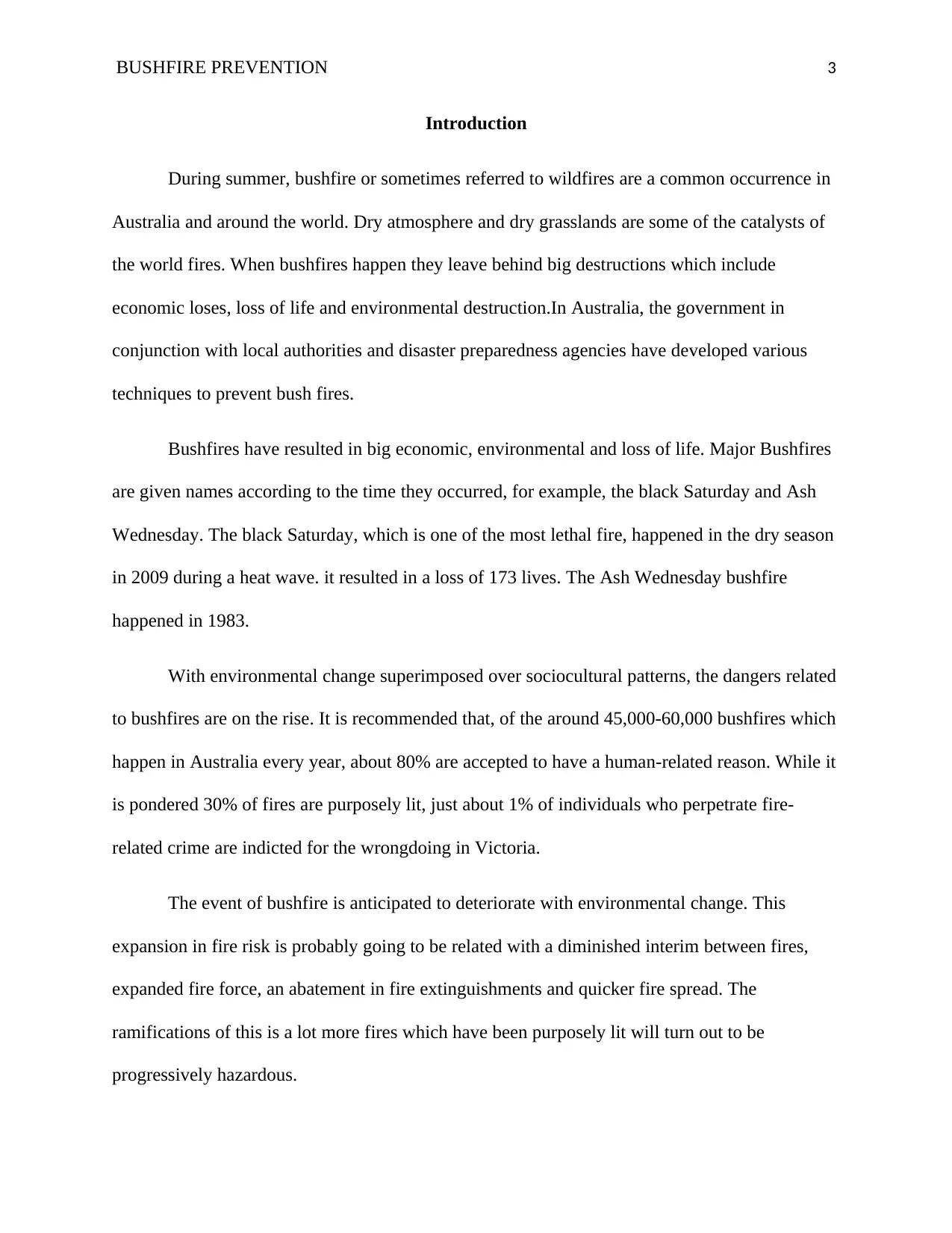
BUSHFIRE PREVENTION 3
Introduction
During summer, bushfire or sometimes referred to wildfires are a common occurrence in
Australia and around the world. Dry atmosphere and dry grasslands are some of the catalysts of
the world fires. When bushfires happen they leave behind big destructions which include
economic loses, loss of life and environmental destruction.In Australia, the government in
conjunction with local authorities and disaster preparedness agencies have developed various
techniques to prevent bush fires.
Bushfires have resulted in big economic, environmental and loss of life. Major Bushfires
are given names according to the time they occurred, for example, the black Saturday and Ash
Wednesday. The black Saturday, which is one of the most lethal fire, happened in the dry season
in 2009 during a heat wave. it resulted in a loss of 173 lives. The Ash Wednesday bushfire
happened in 1983.
With environmental change superimposed over sociocultural patterns, the dangers related
to bushfires are on the rise. It is recommended that, of the around 45,000-60,000 bushfires which
happen in Australia every year, about 80% are accepted to have a human-related reason. While it
is pondered 30% of fires are purposely lit, just about 1% of individuals who perpetrate fire-
related crime are indicted for the wrongdoing in Victoria.
The event of bushfire is anticipated to deteriorate with environmental change. This
expansion in fire risk is probably going to be related with a diminished interim between fires,
expanded fire force, an abatement in fire extinguishments and quicker fire spread. The
ramifications of this is a lot more fires which have been purposely lit will turn out to be
progressively hazardous.
Introduction
During summer, bushfire or sometimes referred to wildfires are a common occurrence in
Australia and around the world. Dry atmosphere and dry grasslands are some of the catalysts of
the world fires. When bushfires happen they leave behind big destructions which include
economic loses, loss of life and environmental destruction.In Australia, the government in
conjunction with local authorities and disaster preparedness agencies have developed various
techniques to prevent bush fires.
Bushfires have resulted in big economic, environmental and loss of life. Major Bushfires
are given names according to the time they occurred, for example, the black Saturday and Ash
Wednesday. The black Saturday, which is one of the most lethal fire, happened in the dry season
in 2009 during a heat wave. it resulted in a loss of 173 lives. The Ash Wednesday bushfire
happened in 1983.
With environmental change superimposed over sociocultural patterns, the dangers related
to bushfires are on the rise. It is recommended that, of the around 45,000-60,000 bushfires which
happen in Australia every year, about 80% are accepted to have a human-related reason. While it
is pondered 30% of fires are purposely lit, just about 1% of individuals who perpetrate fire-
related crime are indicted for the wrongdoing in Victoria.
The event of bushfire is anticipated to deteriorate with environmental change. This
expansion in fire risk is probably going to be related with a diminished interim between fires,
expanded fire force, an abatement in fire extinguishments and quicker fire spread. The
ramifications of this is a lot more fires which have been purposely lit will turn out to be
progressively hazardous.
⊘ This is a preview!⊘
Do you want full access?
Subscribe today to unlock all pages.

Trusted by 1+ million students worldwide
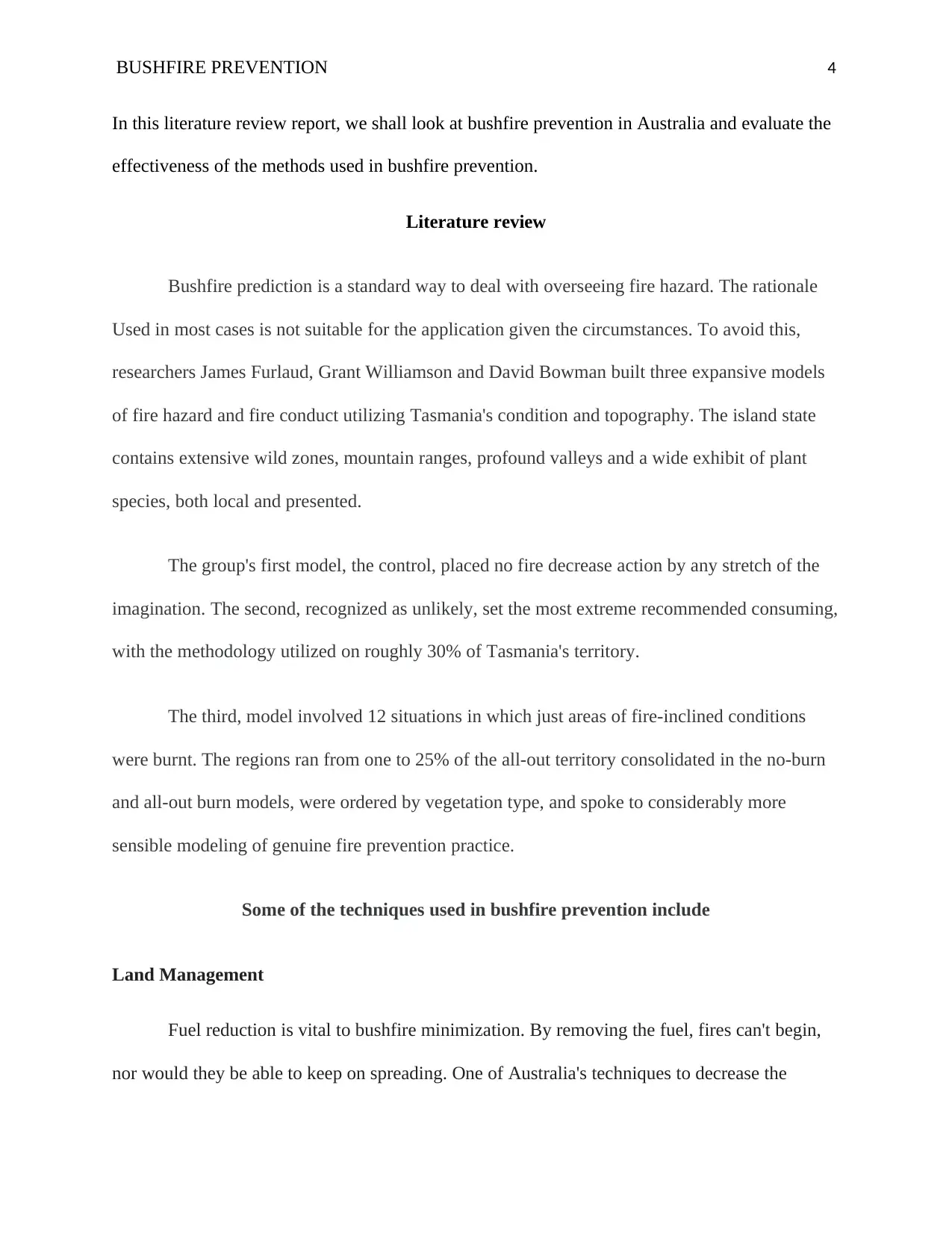
BUSHFIRE PREVENTION 4
In this literature review report, we shall look at bushfire prevention in Australia and evaluate the
effectiveness of the methods used in bushfire prevention.
Literature review
Bushfire prediction is a standard way to deal with overseeing fire hazard. The rationale
Used in most cases is not suitable for the application given the circumstances. To avoid this,
researchers James Furlaud, Grant Williamson and David Bowman built three expansive models
of fire hazard and fire conduct utilizing Tasmania's condition and topography. The island state
contains extensive wild zones, mountain ranges, profound valleys and a wide exhibit of plant
species, both local and presented.
The group's first model, the control, placed no fire decrease action by any stretch of the
imagination. The second, recognized as unlikely, set the most extreme recommended consuming,
with the methodology utilized on roughly 30% of Tasmania's territory.
The third, model involved 12 situations in which just areas of fire-inclined conditions
were burnt. The regions ran from one to 25% of the all-out territory consolidated in the no-burn
and all-out burn models, were ordered by vegetation type, and spoke to considerably more
sensible modeling of genuine fire prevention practice.
Some of the techniques used in bushfire prevention include
Land Management
Fuel reduction is vital to bushfire minimization. By removing the fuel, fires can't begin,
nor would they be able to keep on spreading. One of Australia's techniques to decrease the
In this literature review report, we shall look at bushfire prevention in Australia and evaluate the
effectiveness of the methods used in bushfire prevention.
Literature review
Bushfire prediction is a standard way to deal with overseeing fire hazard. The rationale
Used in most cases is not suitable for the application given the circumstances. To avoid this,
researchers James Furlaud, Grant Williamson and David Bowman built three expansive models
of fire hazard and fire conduct utilizing Tasmania's condition and topography. The island state
contains extensive wild zones, mountain ranges, profound valleys and a wide exhibit of plant
species, both local and presented.
The group's first model, the control, placed no fire decrease action by any stretch of the
imagination. The second, recognized as unlikely, set the most extreme recommended consuming,
with the methodology utilized on roughly 30% of Tasmania's territory.
The third, model involved 12 situations in which just areas of fire-inclined conditions
were burnt. The regions ran from one to 25% of the all-out territory consolidated in the no-burn
and all-out burn models, were ordered by vegetation type, and spoke to considerably more
sensible modeling of genuine fire prevention practice.
Some of the techniques used in bushfire prevention include
Land Management
Fuel reduction is vital to bushfire minimization. By removing the fuel, fires can't begin,
nor would they be able to keep on spreading. One of Australia's techniques to decrease the
Paraphrase This Document
Need a fresh take? Get an instant paraphrase of this document with our AI Paraphraser
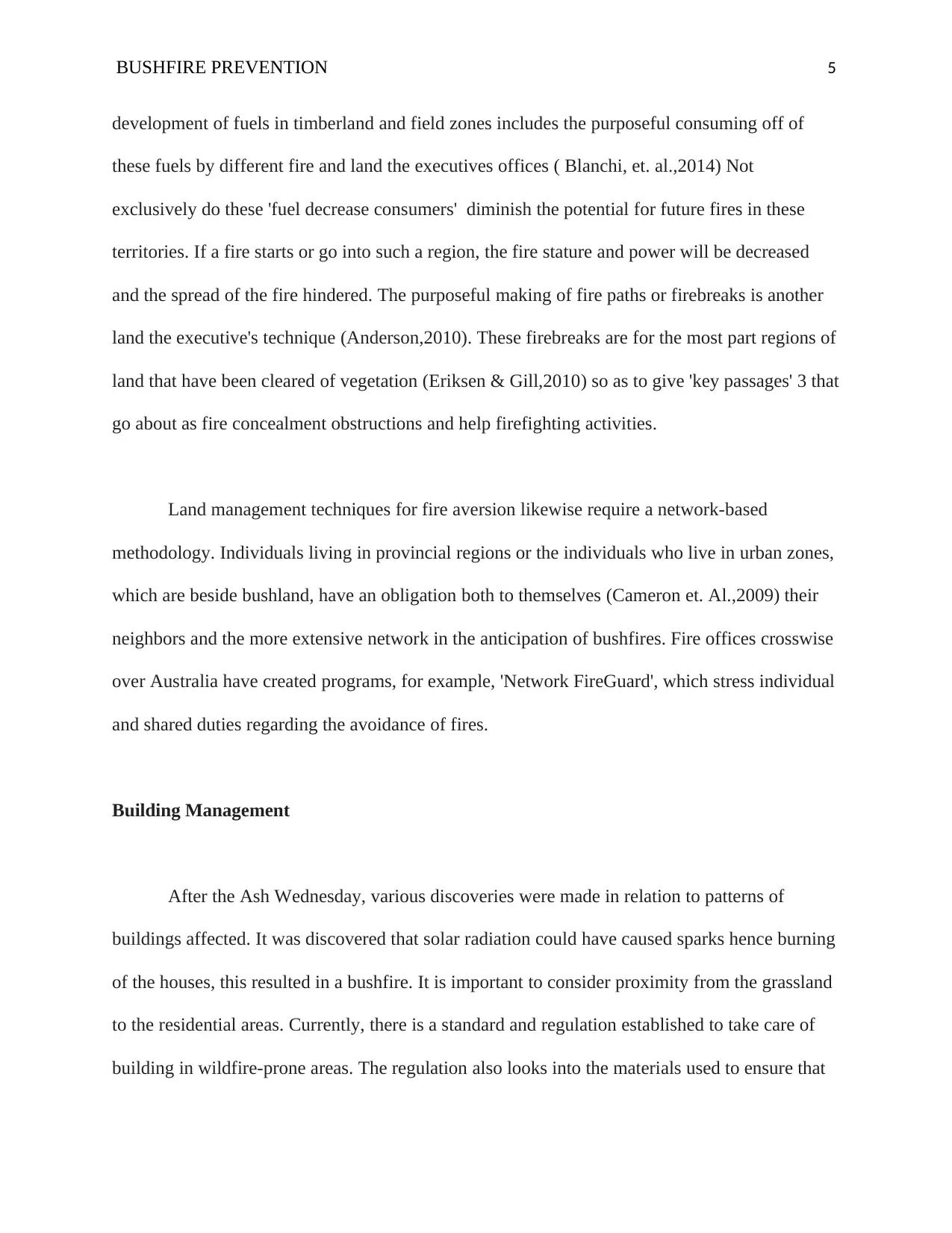
BUSHFIRE PREVENTION 5
development of fuels in timberland and field zones includes the purposeful consuming off of
these fuels by different fire and land the executives offices ( Blanchi, et. al.,2014) Not
exclusively do these 'fuel decrease consumers' diminish the potential for future fires in these
territories. If a fire starts or go into such a region, the fire stature and power will be decreased
and the spread of the fire hindered. The purposeful making of fire paths or firebreaks is another
land the executive's technique (Anderson,2010). These firebreaks are for the most part regions of
land that have been cleared of vegetation (Eriksen & Gill,2010) so as to give 'key passages' 3 that
go about as fire concealment obstructions and help firefighting activities.
Land management techniques for fire aversion likewise require a network-based
methodology. Individuals living in provincial regions or the individuals who live in urban zones,
which are beside bushland, have an obligation both to themselves (Cameron et. Al.,2009) their
neighbors and the more extensive network in the anticipation of bushfires. Fire offices crosswise
over Australia have created programs, for example, 'Network FireGuard', which stress individual
and shared duties regarding the avoidance of fires.
Building Management
After the Ash Wednesday, various discoveries were made in relation to patterns of
buildings affected. It was discovered that solar radiation could have caused sparks hence burning
of the houses, this resulted in a bushfire. It is important to consider proximity from the grassland
to the residential areas. Currently, there is a standard and regulation established to take care of
building in wildfire-prone areas. The regulation also looks into the materials used to ensure that
development of fuels in timberland and field zones includes the purposeful consuming off of
these fuels by different fire and land the executives offices ( Blanchi, et. al.,2014) Not
exclusively do these 'fuel decrease consumers' diminish the potential for future fires in these
territories. If a fire starts or go into such a region, the fire stature and power will be decreased
and the spread of the fire hindered. The purposeful making of fire paths or firebreaks is another
land the executive's technique (Anderson,2010). These firebreaks are for the most part regions of
land that have been cleared of vegetation (Eriksen & Gill,2010) so as to give 'key passages' 3 that
go about as fire concealment obstructions and help firefighting activities.
Land management techniques for fire aversion likewise require a network-based
methodology. Individuals living in provincial regions or the individuals who live in urban zones,
which are beside bushland, have an obligation both to themselves (Cameron et. Al.,2009) their
neighbors and the more extensive network in the anticipation of bushfires. Fire offices crosswise
over Australia have created programs, for example, 'Network FireGuard', which stress individual
and shared duties regarding the avoidance of fires.
Building Management
After the Ash Wednesday, various discoveries were made in relation to patterns of
buildings affected. It was discovered that solar radiation could have caused sparks hence burning
of the houses, this resulted in a bushfire. It is important to consider proximity from the grassland
to the residential areas. Currently, there is a standard and regulation established to take care of
building in wildfire-prone areas. The regulation also looks into the materials used to ensure that
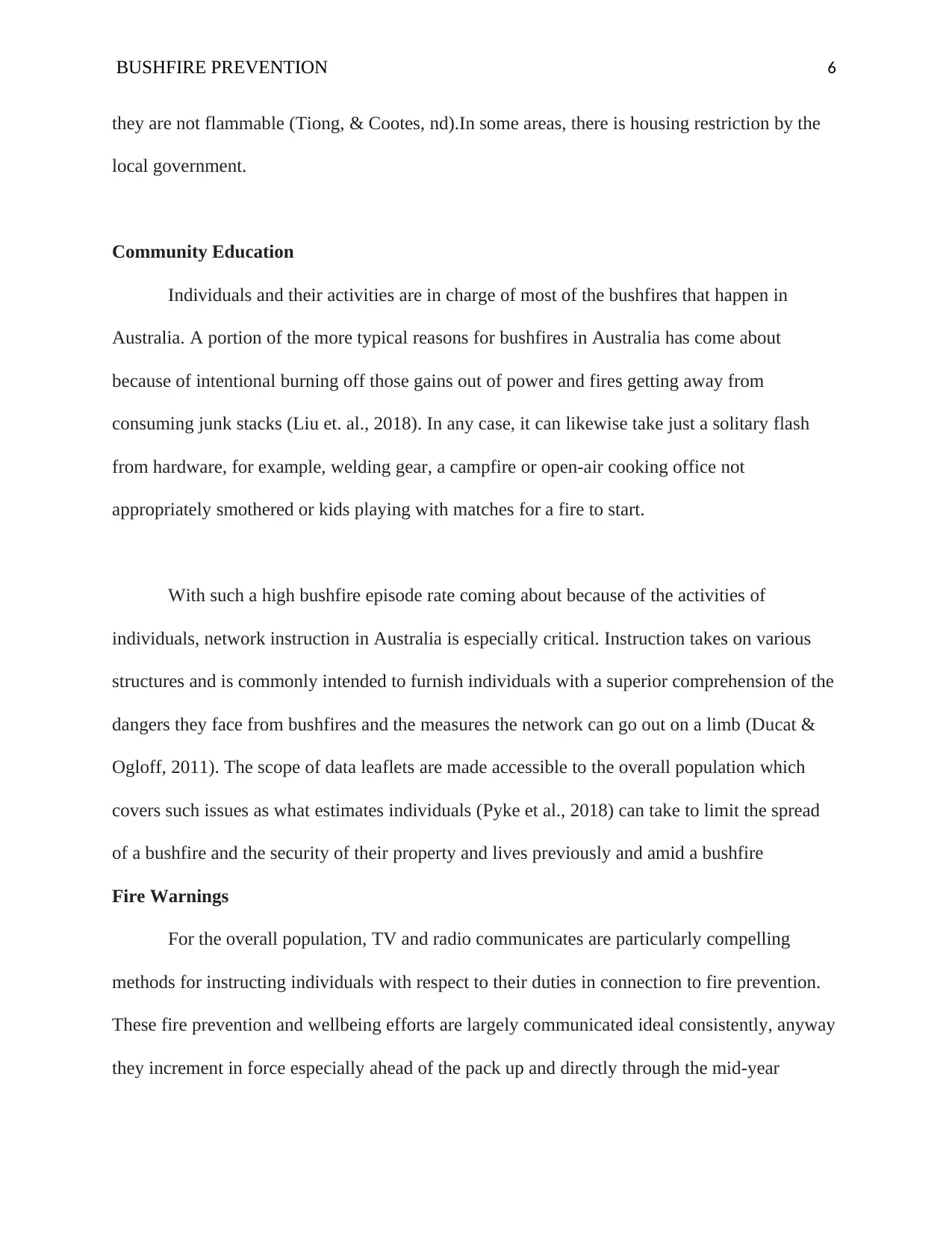
BUSHFIRE PREVENTION 6
they are not flammable (Tiong, & Cootes, nd).In some areas, there is housing restriction by the
local government.
Community Education
Individuals and their activities are in charge of most of the bushfires that happen in
Australia. A portion of the more typical reasons for bushfires in Australia has come about
because of intentional burning off those gains out of power and fires getting away from
consuming junk stacks (Liu et. al., 2018). In any case, it can likewise take just a solitary flash
from hardware, for example, welding gear, a campfire or open-air cooking office not
appropriately smothered or kids playing with matches for a fire to start.
With such a high bushfire episode rate coming about because of the activities of
individuals, network instruction in Australia is especially critical. Instruction takes on various
structures and is commonly intended to furnish individuals with a superior comprehension of the
dangers they face from bushfires and the measures the network can go out on a limb (Ducat &
Ogloff, 2011). The scope of data leaflets are made accessible to the overall population which
covers such issues as what estimates individuals (Pyke et al., 2018) can take to limit the spread
of a bushfire and the security of their property and lives previously and amid a bushfire
Fire Warnings
For the overall population, TV and radio communicates are particularly compelling
methods for instructing individuals with respect to their duties in connection to fire prevention.
These fire prevention and wellbeing efforts are largely communicated ideal consistently, anyway
they increment in force especially ahead of the pack up and directly through the mid-year
they are not flammable (Tiong, & Cootes, nd).In some areas, there is housing restriction by the
local government.
Community Education
Individuals and their activities are in charge of most of the bushfires that happen in
Australia. A portion of the more typical reasons for bushfires in Australia has come about
because of intentional burning off those gains out of power and fires getting away from
consuming junk stacks (Liu et. al., 2018). In any case, it can likewise take just a solitary flash
from hardware, for example, welding gear, a campfire or open-air cooking office not
appropriately smothered or kids playing with matches for a fire to start.
With such a high bushfire episode rate coming about because of the activities of
individuals, network instruction in Australia is especially critical. Instruction takes on various
structures and is commonly intended to furnish individuals with a superior comprehension of the
dangers they face from bushfires and the measures the network can go out on a limb (Ducat &
Ogloff, 2011). The scope of data leaflets are made accessible to the overall population which
covers such issues as what estimates individuals (Pyke et al., 2018) can take to limit the spread
of a bushfire and the security of their property and lives previously and amid a bushfire
Fire Warnings
For the overall population, TV and radio communicates are particularly compelling
methods for instructing individuals with respect to their duties in connection to fire prevention.
These fire prevention and wellbeing efforts are largely communicated ideal consistently, anyway
they increment in force especially ahead of the pack up and directly through the mid-year
⊘ This is a preview!⊘
Do you want full access?
Subscribe today to unlock all pages.

Trusted by 1+ million students worldwide
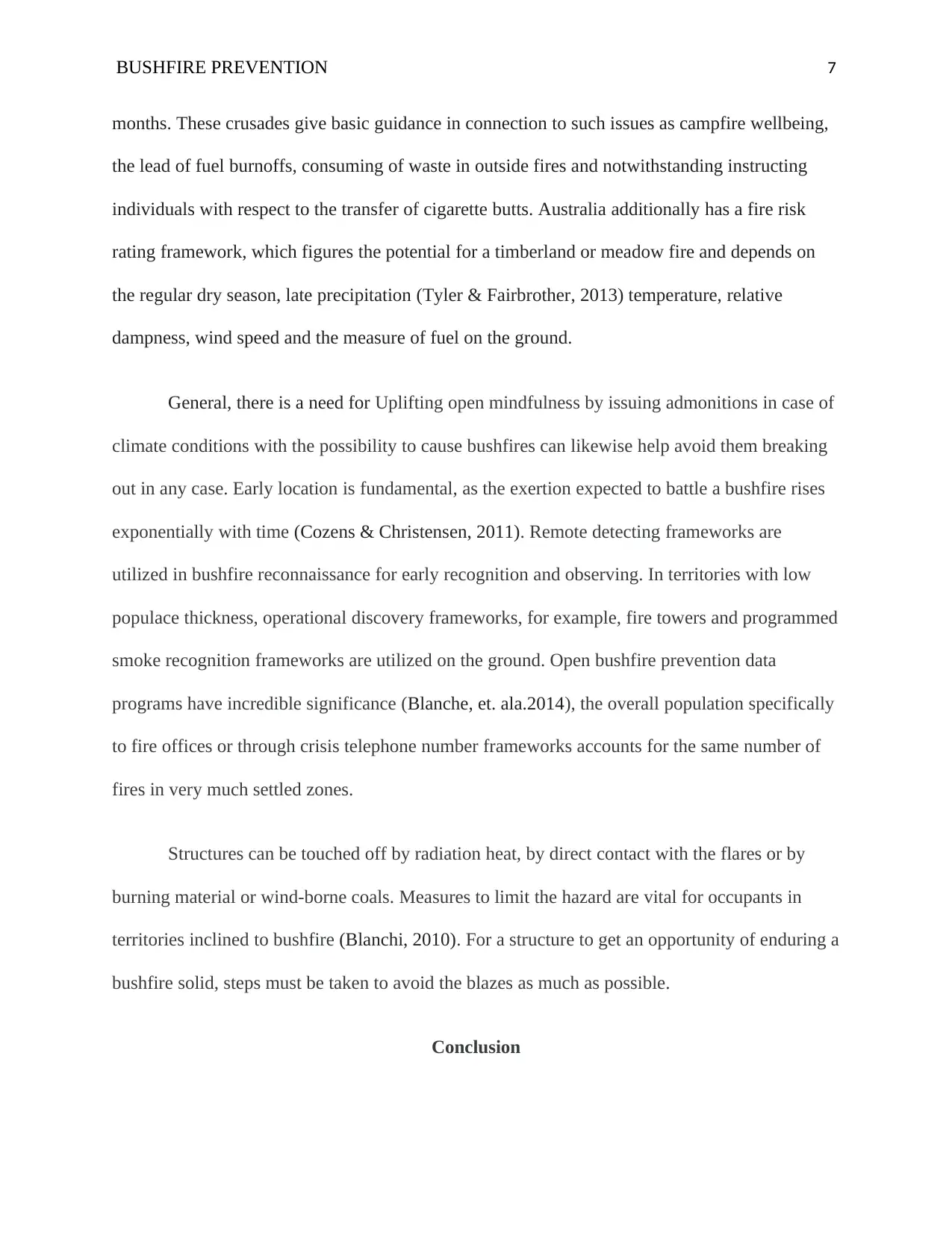
BUSHFIRE PREVENTION 7
months. These crusades give basic guidance in connection to such issues as campfire wellbeing,
the lead of fuel burnoffs, consuming of waste in outside fires and notwithstanding instructing
individuals with respect to the transfer of cigarette butts. Australia additionally has a fire risk
rating framework, which figures the potential for a timberland or meadow fire and depends on
the regular dry season, late precipitation (Tyler & Fairbrother, 2013) temperature, relative
dampness, wind speed and the measure of fuel on the ground.
General, there is a need for Uplifting open mindfulness by issuing admonitions in case of
climate conditions with the possibility to cause bushfires can likewise help avoid them breaking
out in any case. Early location is fundamental, as the exertion expected to battle a bushfire rises
exponentially with time (Cozens & Christensen, 2011). Remote detecting frameworks are
utilized in bushfire reconnaissance for early recognition and observing. In territories with low
populace thickness, operational discovery frameworks, for example, fire towers and programmed
smoke recognition frameworks are utilized on the ground. Open bushfire prevention data
programs have incredible significance (Blanche, et. ala.2014), the overall population specifically
to fire offices or through crisis telephone number frameworks accounts for the same number of
fires in very much settled zones.
Structures can be touched off by radiation heat, by direct contact with the flares or by
burning material or wind-borne coals. Measures to limit the hazard are vital for occupants in
territories inclined to bushfire (Blanchi, 2010). For a structure to get an opportunity of enduring a
bushfire solid, steps must be taken to avoid the blazes as much as possible.
Conclusion
months. These crusades give basic guidance in connection to such issues as campfire wellbeing,
the lead of fuel burnoffs, consuming of waste in outside fires and notwithstanding instructing
individuals with respect to the transfer of cigarette butts. Australia additionally has a fire risk
rating framework, which figures the potential for a timberland or meadow fire and depends on
the regular dry season, late precipitation (Tyler & Fairbrother, 2013) temperature, relative
dampness, wind speed and the measure of fuel on the ground.
General, there is a need for Uplifting open mindfulness by issuing admonitions in case of
climate conditions with the possibility to cause bushfires can likewise help avoid them breaking
out in any case. Early location is fundamental, as the exertion expected to battle a bushfire rises
exponentially with time (Cozens & Christensen, 2011). Remote detecting frameworks are
utilized in bushfire reconnaissance for early recognition and observing. In territories with low
populace thickness, operational discovery frameworks, for example, fire towers and programmed
smoke recognition frameworks are utilized on the ground. Open bushfire prevention data
programs have incredible significance (Blanche, et. ala.2014), the overall population specifically
to fire offices or through crisis telephone number frameworks accounts for the same number of
fires in very much settled zones.
Structures can be touched off by radiation heat, by direct contact with the flares or by
burning material or wind-borne coals. Measures to limit the hazard are vital for occupants in
territories inclined to bushfire (Blanchi, 2010). For a structure to get an opportunity of enduring a
bushfire solid, steps must be taken to avoid the blazes as much as possible.
Conclusion
Paraphrase This Document
Need a fresh take? Get an instant paraphrase of this document with our AI Paraphraser
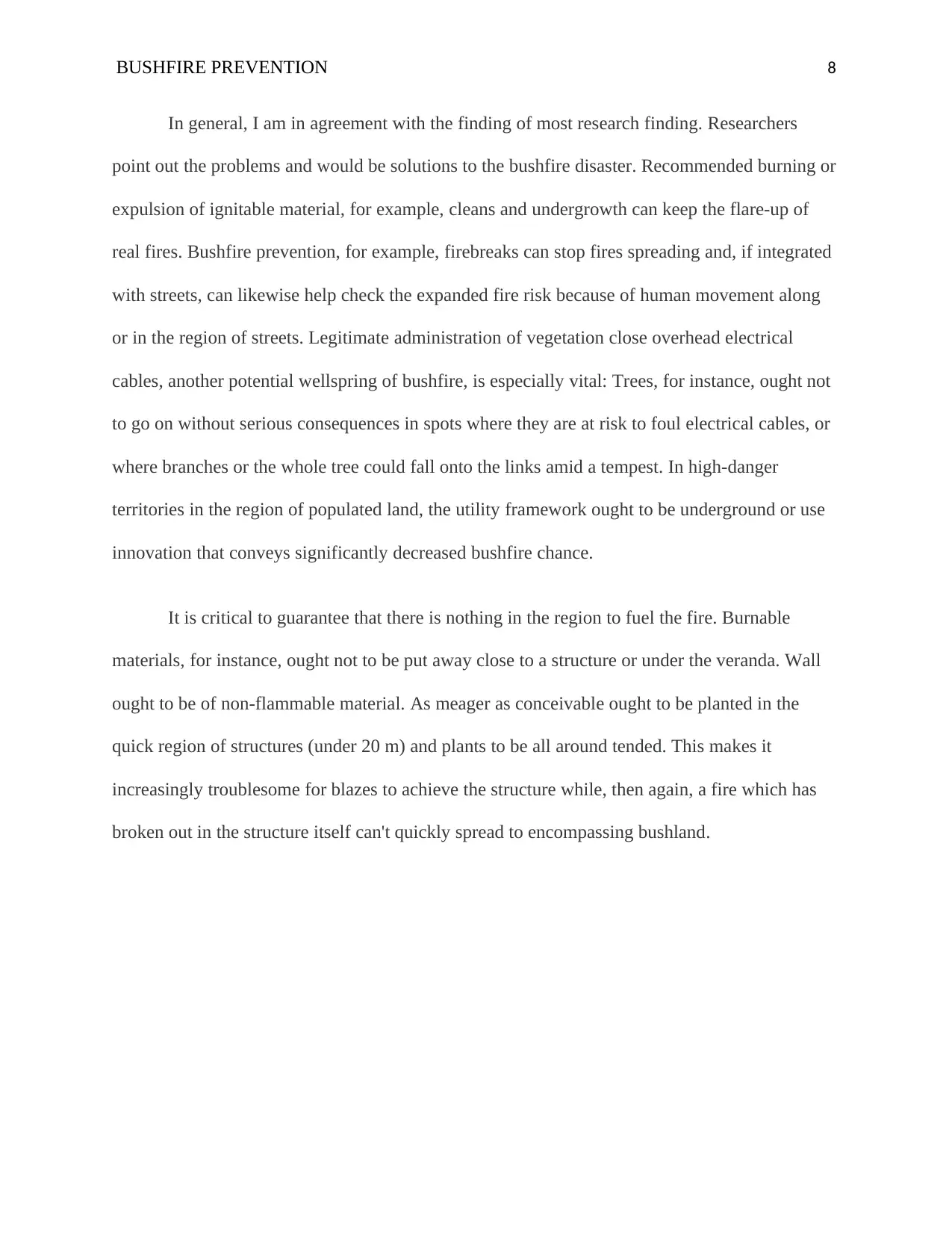
BUSHFIRE PREVENTION 8
In general, I am in agreement with the finding of most research finding. Researchers
point out the problems and would be solutions to the bushfire disaster. Recommended burning or
expulsion of ignitable material, for example, cleans and undergrowth can keep the flare-up of
real fires. Bushfire prevention, for example, firebreaks can stop fires spreading and, if integrated
with streets, can likewise help check the expanded fire risk because of human movement along
or in the region of streets. Legitimate administration of vegetation close overhead electrical
cables, another potential wellspring of bushfire, is especially vital: Trees, for instance, ought not
to go on without serious consequences in spots where they are at risk to foul electrical cables, or
where branches or the whole tree could fall onto the links amid a tempest. In high-danger
territories in the region of populated land, the utility framework ought to be underground or use
innovation that conveys significantly decreased bushfire chance.
It is critical to guarantee that there is nothing in the region to fuel the fire. Burnable
materials, for instance, ought not to be put away close to a structure or under the veranda. Wall
ought to be of non-flammable material. As meager as conceivable ought to be planted in the
quick region of structures (under 20 m) and plants to be all around tended. This makes it
increasingly troublesome for blazes to achieve the structure while, then again, a fire which has
broken out in the structure itself can't quickly spread to encompassing bushland.
In general, I am in agreement with the finding of most research finding. Researchers
point out the problems and would be solutions to the bushfire disaster. Recommended burning or
expulsion of ignitable material, for example, cleans and undergrowth can keep the flare-up of
real fires. Bushfire prevention, for example, firebreaks can stop fires spreading and, if integrated
with streets, can likewise help check the expanded fire risk because of human movement along
or in the region of streets. Legitimate administration of vegetation close overhead electrical
cables, another potential wellspring of bushfire, is especially vital: Trees, for instance, ought not
to go on without serious consequences in spots where they are at risk to foul electrical cables, or
where branches or the whole tree could fall onto the links amid a tempest. In high-danger
territories in the region of populated land, the utility framework ought to be underground or use
innovation that conveys significantly decreased bushfire chance.
It is critical to guarantee that there is nothing in the region to fuel the fire. Burnable
materials, for instance, ought not to be put away close to a structure or under the veranda. Wall
ought to be of non-flammable material. As meager as conceivable ought to be planted in the
quick region of structures (under 20 m) and plants to be all around tended. This makes it
increasingly troublesome for blazes to achieve the structure while, then again, a fire which has
broken out in the structure itself can't quickly spread to encompassing bushland.
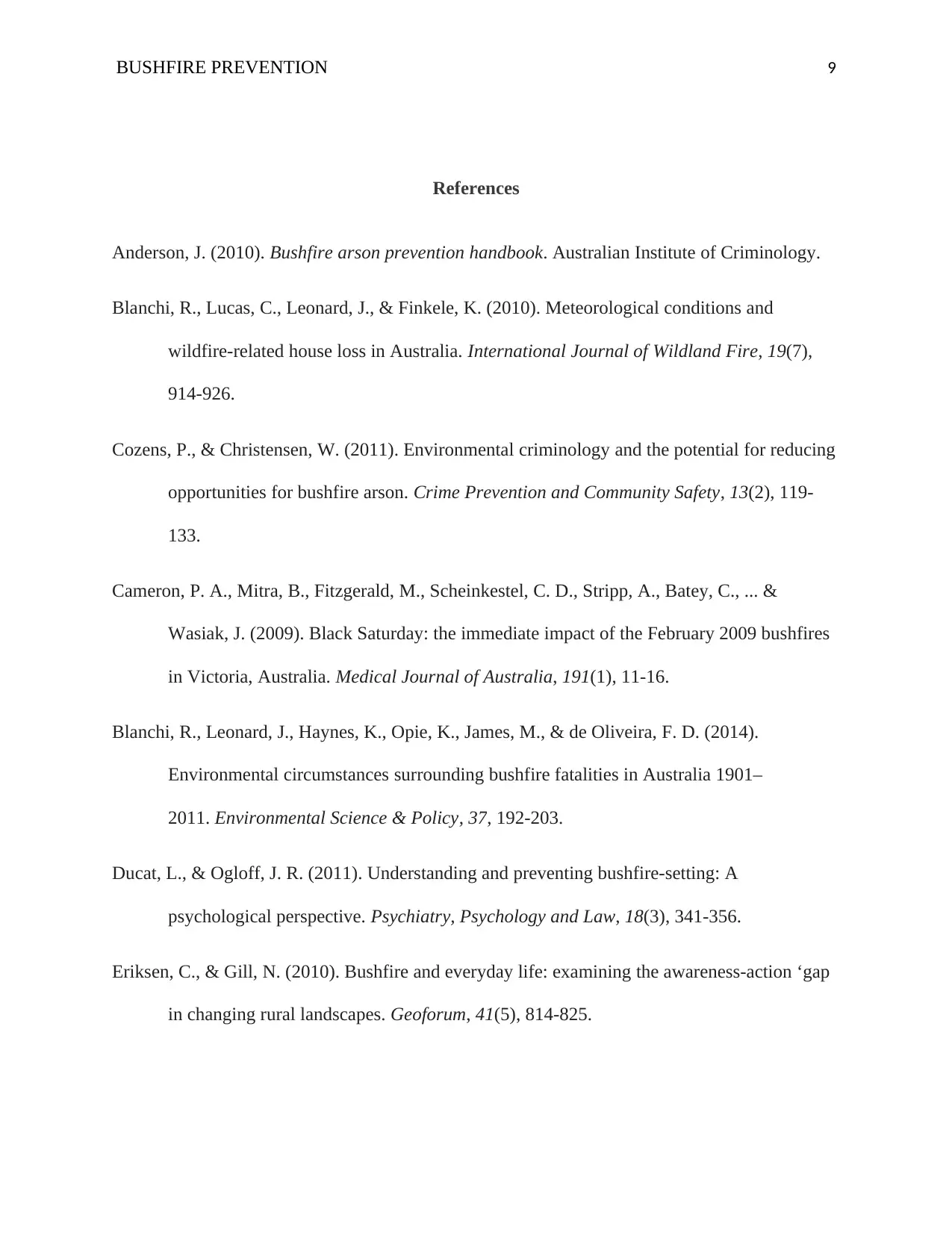
BUSHFIRE PREVENTION 9
References
Anderson, J. (2010). Bushfire arson prevention handbook. Australian Institute of Criminology.
Blanchi, R., Lucas, C., Leonard, J., & Finkele, K. (2010). Meteorological conditions and
wildfire-related house loss in Australia. International Journal of Wildland Fire, 19(7),
914-926.
Cozens, P., & Christensen, W. (2011). Environmental criminology and the potential for reducing
opportunities for bushfire arson. Crime Prevention and Community Safety, 13(2), 119-
133.
Cameron, P. A., Mitra, B., Fitzgerald, M., Scheinkestel, C. D., Stripp, A., Batey, C., ... &
Wasiak, J. (2009). Black Saturday: the immediate impact of the February 2009 bushfires
in Victoria, Australia. Medical Journal of Australia, 191(1), 11-16.
Blanchi, R., Leonard, J., Haynes, K., Opie, K., James, M., & de Oliveira, F. D. (2014).
Environmental circumstances surrounding bushfire fatalities in Australia 1901–
2011. Environmental Science & Policy, 37, 192-203.
Ducat, L., & Ogloff, J. R. (2011). Understanding and preventing bushfire-setting: A
psychological perspective. Psychiatry, Psychology and Law, 18(3), 341-356.
Eriksen, C., & Gill, N. (2010). Bushfire and everyday life: examining the awareness-action ‘gap
in changing rural landscapes. Geoforum, 41(5), 814-825.
References
Anderson, J. (2010). Bushfire arson prevention handbook. Australian Institute of Criminology.
Blanchi, R., Lucas, C., Leonard, J., & Finkele, K. (2010). Meteorological conditions and
wildfire-related house loss in Australia. International Journal of Wildland Fire, 19(7),
914-926.
Cozens, P., & Christensen, W. (2011). Environmental criminology and the potential for reducing
opportunities for bushfire arson. Crime Prevention and Community Safety, 13(2), 119-
133.
Cameron, P. A., Mitra, B., Fitzgerald, M., Scheinkestel, C. D., Stripp, A., Batey, C., ... &
Wasiak, J. (2009). Black Saturday: the immediate impact of the February 2009 bushfires
in Victoria, Australia. Medical Journal of Australia, 191(1), 11-16.
Blanchi, R., Leonard, J., Haynes, K., Opie, K., James, M., & de Oliveira, F. D. (2014).
Environmental circumstances surrounding bushfire fatalities in Australia 1901–
2011. Environmental Science & Policy, 37, 192-203.
Ducat, L., & Ogloff, J. R. (2011). Understanding and preventing bushfire-setting: A
psychological perspective. Psychiatry, Psychology and Law, 18(3), 341-356.
Eriksen, C., & Gill, N. (2010). Bushfire and everyday life: examining the awareness-action ‘gap
in changing rural landscapes. Geoforum, 41(5), 814-825.
⊘ This is a preview!⊘
Do you want full access?
Subscribe today to unlock all pages.

Trusted by 1+ million students worldwide
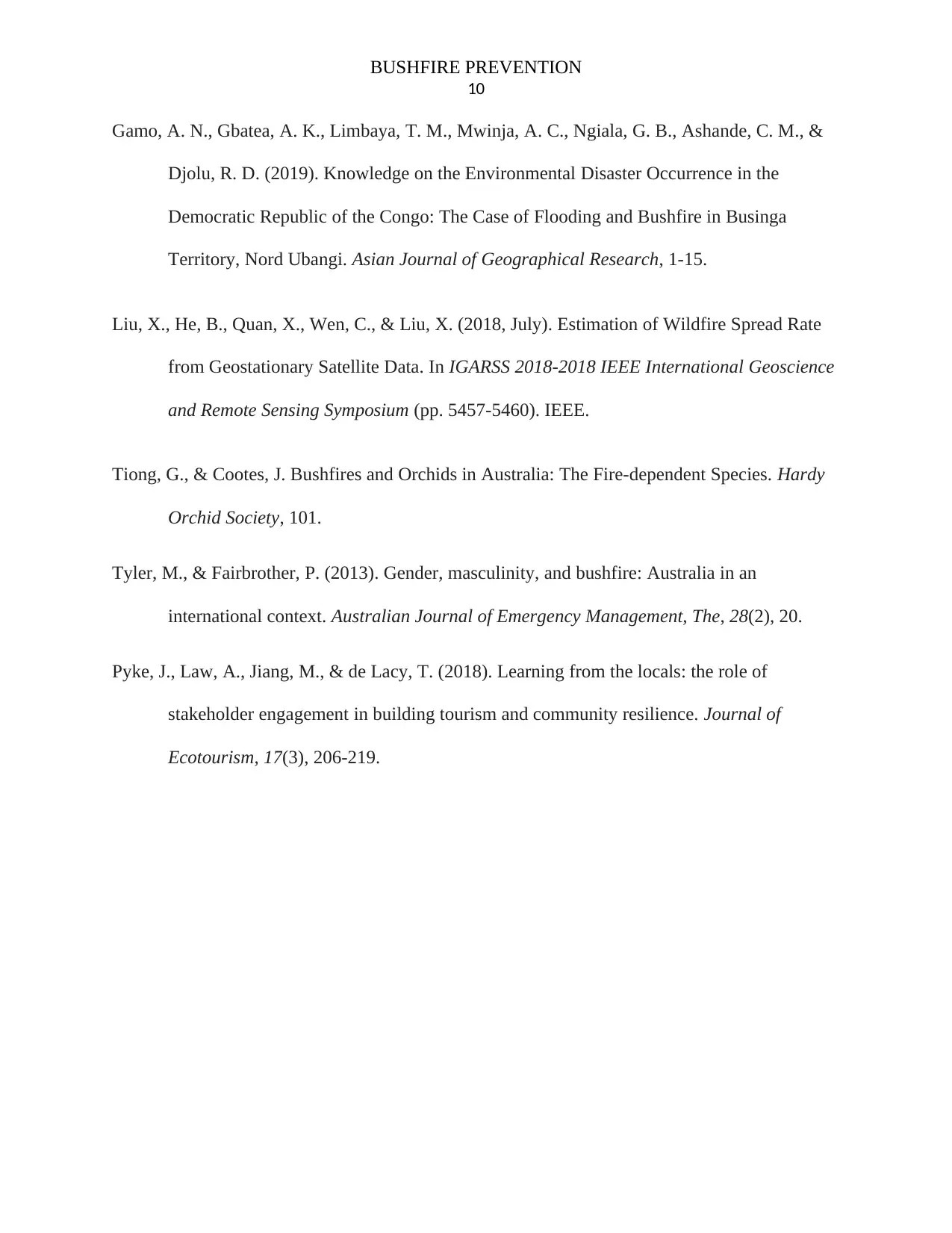
BUSHFIRE PREVENTION
10
Gamo, A. N., Gbatea, A. K., Limbaya, T. M., Mwinja, A. C., Ngiala, G. B., Ashande, C. M., &
Djolu, R. D. (2019). Knowledge on the Environmental Disaster Occurrence in the
Democratic Republic of the Congo: The Case of Flooding and Bushfire in Businga
Territory, Nord Ubangi. Asian Journal of Geographical Research, 1-15.
Liu, X., He, B., Quan, X., Wen, C., & Liu, X. (2018, July). Estimation of Wildfire Spread Rate
from Geostationary Satellite Data. In IGARSS 2018-2018 IEEE International Geoscience
and Remote Sensing Symposium (pp. 5457-5460). IEEE.
Tiong, G., & Cootes, J. Bushfires and Orchids in Australia: The Fire-dependent Species. Hardy
Orchid Society, 101.
Tyler, M., & Fairbrother, P. (2013). Gender, masculinity, and bushfire: Australia in an
international context. Australian Journal of Emergency Management, The, 28(2), 20.
Pyke, J., Law, A., Jiang, M., & de Lacy, T. (2018). Learning from the locals: the role of
stakeholder engagement in building tourism and community resilience. Journal of
Ecotourism, 17(3), 206-219.
10
Gamo, A. N., Gbatea, A. K., Limbaya, T. M., Mwinja, A. C., Ngiala, G. B., Ashande, C. M., &
Djolu, R. D. (2019). Knowledge on the Environmental Disaster Occurrence in the
Democratic Republic of the Congo: The Case of Flooding and Bushfire in Businga
Territory, Nord Ubangi. Asian Journal of Geographical Research, 1-15.
Liu, X., He, B., Quan, X., Wen, C., & Liu, X. (2018, July). Estimation of Wildfire Spread Rate
from Geostationary Satellite Data. In IGARSS 2018-2018 IEEE International Geoscience
and Remote Sensing Symposium (pp. 5457-5460). IEEE.
Tiong, G., & Cootes, J. Bushfires and Orchids in Australia: The Fire-dependent Species. Hardy
Orchid Society, 101.
Tyler, M., & Fairbrother, P. (2013). Gender, masculinity, and bushfire: Australia in an
international context. Australian Journal of Emergency Management, The, 28(2), 20.
Pyke, J., Law, A., Jiang, M., & de Lacy, T. (2018). Learning from the locals: the role of
stakeholder engagement in building tourism and community resilience. Journal of
Ecotourism, 17(3), 206-219.
1 out of 10
Your All-in-One AI-Powered Toolkit for Academic Success.
+13062052269
info@desklib.com
Available 24*7 on WhatsApp / Email
![[object Object]](/_next/static/media/star-bottom.7253800d.svg)
Unlock your academic potential
Copyright © 2020–2025 A2Z Services. All Rights Reserved. Developed and managed by ZUCOL.